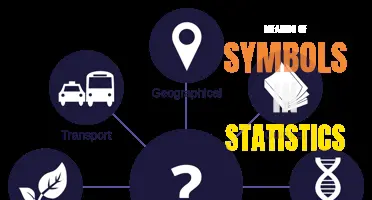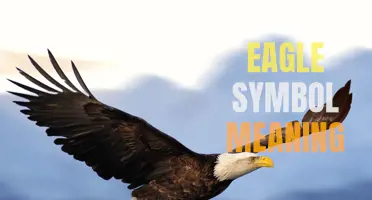
Morocco is a country abundant in rich culture and history, and its symbols and meanings serve as a window into its fascinating past. From the intricate patterns of its traditional architecture to the vibrant colors and symbolism of its traditional clothing and jewelry, Moroccan symbols offer a glimpse into the country's diverse heritage and the stories embedded within them. These symbols not only capture Morocco's multicultural influences but also showcase its deep connection to nature, spirituality, and community. Whether it's the iconic Moorish arches, the hamsa hand, or the well-known berber symbols, each holds a unique significance and reflects the essence of Moroccan culture. Join me on a journey to explore the magical world of Moroccan symbols and meanings, and uncover the hidden stories behind these captivating elements of Moroccan identity.
What You'll Learn
- What are some commonly recognized symbols in Moroccan culture and what do they represent?
- Are there any specific symbols or motifs that are associated with Moroccan art and architecture?
- How does Moroccan symbolism differ from symbols found in other North African or Arab cultures?
- Have the meanings or significance of Moroccan symbols evolved over time?
- Are there any symbols that are particularly significant or sacred in Moroccan religious practices?

What are some commonly recognized symbols in Moroccan culture and what do they represent?
Moroccan culture is rich in symbolism, with many symbols that hold significant meanings and are widely recognized by both Moroccans and foreigners alike. These symbols can be found in various aspects of Moroccan life, including art, architecture, clothing, and even everyday objects.
One of the most well-known symbols in Moroccan culture is the hand of Fatima, also known as the Khamsa or Hamsa. This symbol takes the form of an open palm with an eye in the center, and it is believed to bring good luck and protect against evil spirits. The hand of Fatima is often depicted as a piece of jewelry or an ornament and can be found in many Moroccan homes.
Another symbol commonly seen in Moroccan culture is the Moorish star, also known as the Moroccan star or the star of Solomon. This star is an intricate geometric pattern made up of interlocking circles and is often used in Moroccan architecture, particularly in tile work and plaster carvings. The Moorish star represents harmony, balance, and the interconnectedness of all things.
The Moroccan rug, or the Berber rug, is another important symbol in Moroccan culture. These rugs are hand-woven by Berber women and are known for their vibrant colors and intricate designs. Each rug tells a story and symbolizes the culture and history of the Berber people. The rugs often feature symbols such as diamonds, squares, and zigzag patterns, each with its own meaning and significance.
The symbol of the Moroccan flag, the green pentagram on a red background, is also widely recognized. The green color represents Islam and the pentagram represents the seal of Solomon, a symbol often associated with the Moroccan monarchy.
In addition to these symbols, Moroccan culture is also known for its use of the color blue. The city of Chefchaouen, in particular, is famous for its blue-painted walls, doors, and buildings. The color blue is believed to repel evil spirits and bring good luck, and it is often associated with spirituality and tranquility in Moroccan culture.
Overall, symbols play an integral role in Moroccan culture, representing various aspects of the country's history, religion, and traditions. Whether it's the hand of Fatima, the Moorish star, or the vibrant colors of a Moroccan rug, these symbols serve to connect Moroccans to their cultural heritage and provide a visual representation of their beliefs and values.
Decoding the Dashboard: Understanding John Deere Tractor Symbols and Meanings
You may want to see also

Are there any specific symbols or motifs that are associated with Moroccan art and architecture?
Moroccan art and architecture are known for their intricate designs and vibrant colors. They are heavily influenced by a variety of cultures and religions, resulting in a unique combination of motifs and symbols. These symbols and motifs represent various aspects of Moroccan culture, including its history, religion, and natural environment. Here are some of the most common symbols and motifs found in Moroccan art and architecture.
One of the most iconic symbols in Moroccan art and architecture is the geometric pattern. Geometric patterns are often seen in the tiles, textiles, and woodwork of Moroccan buildings. These patterns are a reflection of the Islamic influence on Moroccan design. Islamic art prohibits the use of figurative representation, so artists and architects turned to geometric patterns to create intricate and visually stunning designs. These patterns often feature symmetrical and repetitive shapes such as stars, hexagons, and squares.
Another common motif in Moroccan art and architecture is the use of calligraphy. Calligraphy is a form of decorative writing that is often used to adorn the walls, ceilings, and doors of Moroccan buildings. Arabic calligraphy is particularly revered in Moroccan art, as it is considered both a form of art and a way to communicate with the divine. Calligraphy is often used to display verses from the Quran or other religious texts, as well as poetic verses and proverbs.
Floral and plant motifs are also prominent in Moroccan art and architecture. These motifs are inspired by the country's lush landscapes and abundant flora. Moroccan artisans often incorporate intricate floral designs into their artwork, rugs, and ceramics. Common floral motifs include roses, vines, palm leaves, and jasmine flowers. These motifs are often combined with other geometric patterns to create a harmonious balance between nature and design.
Another important symbol in Moroccan art and architecture is the hand of Fatima, also known as the Khamsa. The hand of Fatima is an ancient symbol of protection and good fortune, and is believed to ward off evil spirits. It is often depicted as a hand with an eye in the center or with various other symbolic elements. The hand of Fatima can be found in various forms throughout Moroccan art, such as jewelry, ceramics, and wall hangings.
The use of vibrant colors is also a hallmark of Moroccan art and architecture. Moroccan buildings are often painted in bright hues such as blue, green, yellow, and red. These colors are believed to bring good luck and ward off evil spirits. The vibrancy of the colors is also a reflection of the country's sunny climate and its lively atmosphere.
In conclusion, Moroccan art and architecture are characterized by a variety of symbols and motifs that reflect the country's rich cultural heritage. From geometric patterns to calligraphy, floral motifs, and the hand of Fatima, each symbol and motif tells a unique story and adds depth to Morocco's artistic legacy. Whether it's the intricate designs on a mosaic tile or the vibrant colors of a painted wall, Moroccan art and architecture continue to captivate and inspire visitors from around the world.
The Deep Meaning Behind Huichol Symbols: A Fascinating Exploration of Huichol Culture
You may want to see also

How does Moroccan symbolism differ from symbols found in other North African or Arab cultures?
Morocco is a country rich in cultural and historical symbolism. From its architecture to its handicrafts, symbolism is deeply ingrained in Moroccan culture. However, Moroccan symbolism does differ from symbols found in other North African or Arab cultures in several ways.
One major difference is the influence of Berber culture in Morocco. The Berbers are the indigenous people of North Africa, and their influence is particularly strong in Morocco. Berber symbols often feature geometric patterns and motifs, which are commonly found in Moroccan architecture, carpets, and textiles. These geometric symbols are believed to have protective and spiritual powers and are used as a means to ward off evil spirits.
Another significant difference is the influence of Islamic art and symbolism in Moroccan culture. Islam is the predominant religion in Morocco, and its symbols and motifs are widely represented in Moroccan art and architecture. Islamic symbols such as the crescent moon and star are commonly seen in Moroccan architecture, especially in mosques and religious buildings. These symbols represent the Muslim faith and are often used as a symbol of protection and guidance.
Moroccan culture also has unique symbols that are specific to the region. One such symbol is the Hand of Fatima, also known as the Khamsa. The Hand of Fatima is a popular symbol in Moroccan culture and is believed to provide protection against the evil eye. It is often used as a decorative element in jewelry, clothing, and home decor.
Additionally, Moroccan culture has a strong connection to nature, and this is reflected in its symbolism. Symbols such as flowers, birds, and trees are commonly used in Moroccan art and design. These symbols represent nature's beauty and are often used to convey feelings of happiness and harmony.
Overall, Moroccan symbolism differs from symbols found in other North African or Arab cultures due to its unique blend of Berber, Islamic, and regional influences. The use of geometric patterns, Islamic symbols, and nature motifs all contribute to the rich symbolism found in Moroccan culture. Whether it is the intricately designed architecture or the beautifully crafted handicrafts, Moroccan symbolism is a true reflection of the country's vibrant and diverse cultural heritage.
Understanding Massey Ferguson Tractor Dashboard Symbols and Meanings
You may want to see also

Have the meanings or significance of Moroccan symbols evolved over time?
Symbols play a crucial role in the cultural identity of a country, and Morocco is no exception. With a rich history and diverse geography, Morocco is home to numerous symbols that have deep-rooted meanings and significance. These symbols have evolved over time, reflecting the changing dynamics of Moroccan society and its interactions with the world.
One of the most recognizable symbols of Morocco is the star and crescent, which is seen on the country's flag. This symbol has ancient origins and is associated with Islamic tradition. It represents the connection between heaven and earth and symbolizes unity and harmony. While the star and crescent continue to represent the country's Islamic heritage, its significance has evolved to also represent Morocco's national identity and independence.
Another significant symbol in Moroccan culture is the Moroccan mosaic and geometric patterns. These intricate designs can be found in architecture, ceramics, and textiles. These designs have evolved over time, influenced by various cultures and artistic movements. From Islamic art to Mediterranean and Andalusian influences, Moroccan mosaic and geometric patterns showcase the country's historical connections and its multicultural society.
The Moroccan flag itself is also a symbol that has evolved over time. The current flag was adopted in 1915 and consists of a red field with a five-pointed green star in the center. The red color symbolizes strength, valor, and bravery, while the green star represents Islam. However, prior to the adoption of this flag, Morocco had different symbols that represented its various dynasties and rulers. These symbols changed with the rise and fall of different dynasties, reflecting the political landscape of the time.
Moroccan symbols are not limited to flags and geometric patterns but also include various motifs and objects. The hand of Fatima, also known as the Khamsa, is a symbol of protection against the evil eye and is widely used in Moroccan jewelry and decorations. The symbol of the lion is associated with strength and power and can be found in architectural details and artwork. Moroccan symbols also include the Moroccan tea set and mint tea, which symbolize hospitality and friendship.
In recent times, Moroccan symbols have gained global recognition, thanks to the increasing interest in Moroccan culture and tourism. They are now not only symbols of Morocco's cultural identity but also ambassadors of its artistic and historical heritage. Moroccan symbols have become a source of inspiration for designers, artists, and travelers alike, who seek to incorporate their beauty and rich meaning into their work or experience.
In conclusion, the meanings and significance of Moroccan symbols have indeed evolved over time. From ancient Islamic symbols to more recent national and cultural representations, Moroccan symbols reflect the country's history, values, and identity. They serve as a connection between the past and the present, reminding people of Morocco's rich cultural heritage and its place in the world.
The Symbolic Meaning Behind Flickering Lights and What It Signifies
You may want to see also

Are there any symbols that are particularly significant or sacred in Moroccan religious practices?
Morocco is a country known for its rich religious and cultural heritage. Islam is the dominant religion in the country, and as such, there are various symbols that hold significance and are considered sacred in Moroccan religious practices. These symbols have deep spiritual meaning and are revered by the Moroccan people.
One of the most well-known symbols in Moroccan religious practices is the green color. Green is considered the color of Islam and is associated with the Prophet Muhammad. It is believed to symbolize paradise and is often used to decorate mosques and religious buildings. The green color is also commonly seen in traditional Moroccan clothing and is used for special occasions and religious events.
Another significant symbol in Moroccan religious practices is the crescent moon. The crescent moon holds great importance in Islam and is often used to represent the Islamic calendar. It is also seen as a symbol of divinity and is often used in decorative elements in mosques and religious art.
The hand of Fatima, also known as the Khamsa, is another important symbol in Moroccan religious practices. It is a symbol of protection and is believed to ward off evil spirits. The hand of Fatima is often used in jewelry, door knockers, and other decorative elements in Moroccan homes.
Calligraphy is also highly regarded in Moroccan religious practices. Arabic calligraphy, in particular, is considered an art form and is often used to write religious verses from the Quran. These verses are believed to carry a spiritual significance and are often displayed in homes and mosques.
The five pillars of Islam are another important symbol in Moroccan religious practices. These pillars, which include the declaration of faith, prayer, charity, fasting, and pilgrimage, represent the core principles of Islam and serve as a guide for Moroccan Muslims in their daily lives.
Additionally, the Moroccan flag is a symbol that holds significance in religious practices. The flag features a red background with a green pentagram in the center. The red color is said to represent the ancestors' bloodshed for independence, while the green pentagram symbolizes the five pillars of Islam.
In conclusion, there are several symbols that hold significance and are considered sacred in Moroccan religious practices. These symbols encompass various aspects of Islam and represent the beliefs and values of the Moroccan people. From the green color and crescent moon to the hand of Fatima and Arabic calligraphy, these symbols play a vital role in Moroccan culture and spirituality.
Decoding the Bobcat Warning Light Symbols: Understand Their Meanings
You may want to see also
Frequently asked questions
The Moroccan flag holds great symbolism for the country. The red background represents hardiness, bravery, and valor, while the green star in the center represents Islam, which is the dominant religion in Morocco. The five-pointed star is specifically known as the Seal of Solomon, a symbol associated with King Solomon, who is considered a prophet in Islam.
The Hand of Fatima, also known as the Khamsa, is a popular symbol in Moroccan culture. It is believed to offer protection against the Evil Eye and bring good fortune. The symbol depicts a hand with an eye in the center, often surrounded by intricate patterns and symbols. It is widely used as a talisman and can be found in various forms, such as jewelry, wall hangings, and amulets.
The Moroccan star, also known as the Star of David or the Seal of Solomon, is a symbol associated with King Solomon, who is believed to have possessed great wisdom and power. In Moroccan culture, this star represents divine protection, good luck, and harmony. It is often used in decorative motifs, such as in architecture, embroidery, and traditional artwork.
Moroccan carpets, also known as Berber carpets, hold significant symbolism in Moroccan culture. These handwoven rugs often feature intricate patterns and bold colors, each with its own symbolic meaning. The symbols and patterns on the carpets can represent various aspects of Moroccan life, such as fertility, protection from evil spirits, and blessings for the household. Additionally, the act of weaving a carpet is seen as a ritualistic and spiritual process, connecting the weaver to their ancestors and cultural heritage.







